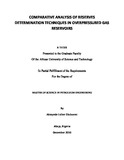| dc.contributor.author | Akinyede, Esther Olubunmi | |
| dc.date.accessioned | 2016-07-18T15:42:23Z | |
| dc.date.available | 2016-07-18T15:42:23Z | |
| dc.date.issued | 2010-12-15 | |
| dc.identifier.uri | http://repository.aust.edu.ng/xmlui/handle/123456789/456 | |
| dc.identifier.uri | http://library.aust.edu.ng:8080/xmlui/handle/123456789/456 | |
| dc.description.abstract | Conventional methods used in determining initial gas-in-place and reserves for a dry gas reservoir entails the use of P/z vs cumulative production data. In a normally pressured gas reservoir, the only important production mechanism is the compressibility of the gas. Many reservoir engineering calculations take advantage of this fact to simplify analysis. However, in deep geopressured gas reservoirs, the compressibility of the gas is much smaller and does not totally dominate production performance. Using simplified approaches may lead to serious errors in these cases. In geopressured systems, the compressibility of the rock and water may be just as large as the gas. Excluding these sources of energy from performance calculations would result in very pessimistic predictions of production versus pressure. Some investigators have postulated that water will be released from shales as the reservoir compacts during depletion. This would result in an internal water drive similar to aquifer influx. Because the reservoir rock is usually highly compressible and under-compacted, the decrease in pore volume during depletion may be very non-linear. Along with the rock compressibility, the absolute permeability may also decrease with declining pressure. Several material balance models have been proposed to calculate the initial gas-in-place for abnormally-pressured gas reservoir.
The present study is concerned with analyzing the different material balance models used to estimate IGIP for abnormally pressured reservoirs, review the bases and assumptions on which these models have been developed, as well as discuss the strength and weakness of every model. In addition, the study comprises comparative analysis of calculations of the IGIP by these material balance models for some reservoir case studies in the Gulf Coast. A sensitivity analysis is also done on some of the input parameters in these material balance models to determine their effect on estimating the original gas-in-place. Moreover, the present investigation reveals that most of the material balance models analyzed in this study are sensitive to the value of the initial reservoir pressure and the early data. Unfortunately, this is the time when reliable estimate for the IGIP is vital for economic decision regarding the development of such gas reservoirs. However, accurate estimation of the IGIP plays an important role in the evaluation, analysis, prediction of future performance, and making economic decision regarding the development of gas reservoirs. | en_US |
| dc.description.sponsorship | AUST | en_US |
| dc.language.iso | en | en_US |
| dc.subject | Akinyede Esther Olubunmi | en_US |
| dc.subject | Prof Djebbar Tiab | en_US |
| dc.subject | 2010 Petroleum Engineering Theses | en_US |
| dc.subject | Gas Reservoirs | en_US |
| dc.subject | Comparative Analysis of Reserves Determination Techniques | en_US |
| dc.subject | Reserves Determination Techniques | en_US |
| dc.title | Comparative Analysis of Reserves Determination Techniques in Overpressured Gas Reservoirs | en_US |
| dc.type | Thesis | en_US |

